Weisheng Hu
Deep Learning Waveform Modeling for Wideband Optical Fiber Channel Transmission: Challenges and Potential Solutions
Jan 14, 2025



Abstract:Fast and accurate optical fiber communication simulation system are crucial for optimizing optical networks, developing digital signal processing algorithms, and performing end-to-end (E2E) optimization. Deep learning (DL) has emerged as a valuable tool to reduce the complexity of traditional waveform simulation methods, such as split-step Fourier method (SSFM). DL-based schemes have achieved high accuracy and low complexity fiber channel waveform modeling as its strong nonlinear fitting ability and high efficiency in parallel computation. However, DL-based schemes are mainly utilized in single-channel and few-channel wavelength division multiplexing (WDM) systems. The applicability of DL-based schemes in wideband WDM systems remains uncertain due to the lack of comparison under consistent standards and scenarios. In this paper, we propose a DSP-assisted accuracy evaluation method to evaluate the performance for DL-based schemes, from the aspects of waveform and quality of transmission (QoT) errors. We compare the performance of five various DL-based schemes and valid the effectiveness of DSP-assisted method in WDM systems. Results suggest that feature decoupled distributed (FDD) achieves the better accuracy, especially in large-channel and high-rate scenarios. Furthermore, we find that the accuracy of FDD still exhibit significant degradation with the number of WDM channels and transmission rates exceeds 15 and 100 GBaud, indicating challenges for wideband applications. We further analyze the reasons of performance degradation from the perspective of increased linearity and nonlinearity and discuss potential solutions including further decoupling scheme designs and improvement in DL models. Despite DL-based schemes remain challenges in wideband WDM systems, they have strong potential for high-accuracy and low-complexity optical fiber channel waveform modeling.
Low Complexity Joint Chromatic Dispersion and Time/Frequency Offset Estimation Based on Fractional Fourier Transform
Nov 07, 2024
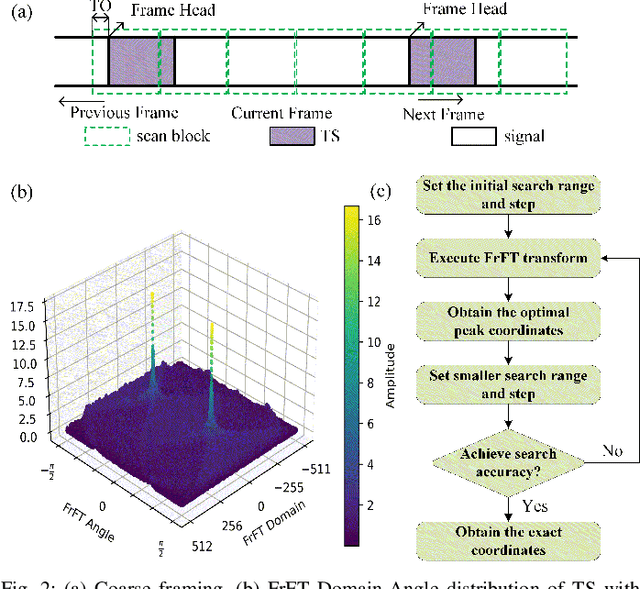
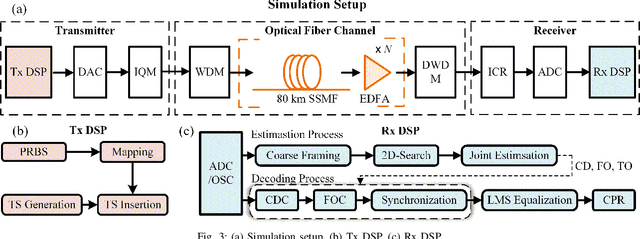
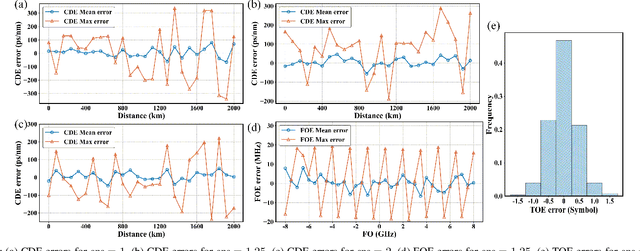
Abstract:We propose and experimentally validate a joint estimation method for chromatic dispersion and time-frequency offset based on the fractional Fourier transform, which reduces computational complexity by more than 50% while keeping estimation accuracy.
Improve the Fitting Accuracy of Deep Learning for the Nonlinear Schrödinger Equation Using Linear Feature Decoupling Method
Nov 07, 2024Abstract:We utilize the Feature Decoupling Distributed (FDD) method to enhance the capability of deep learning to fit the Nonlinear Schrodinger Equation (NLSE), significantly reducing the NLSE loss compared to non decoupling model.
Preamble Design for Joint Frame Synchronization, Frequency Offset Estimation, and Channel Estimation in Upstream Burst-mode Detection of Coherent PONs
Sep 22, 2024Abstract:Coherent optics has demonstrated significant potential as a viable solution for achieving 100 Gb/s and higher speeds in single-wavelength passive optical networks (PON). However, upstream burst-mode coherent detection is a major challenge when adopting coherent optics in access networks. To accelerate digital signal processing (DSP) convergence with a minimal preamble length, we propose a novel burst-mode preamble design based on a constant amplitude zero auto-correlation sequence. This design facilitates comprehensive estimation of linear channel effects in the frequency domain, including polarization state rotation, differential group delay, chromatic dispersion, and polarization-dependent loss, providing overall system response information for channel equalization pre-convergence. Additionally, this preamble utilizes the same training unit to jointly achieve three key DSP functions: frame synchronization, frequency offset estimation, and channel estimation. This integration contributes to a significant reduction in the preamble length. The feasibility of the proposed preamble with a length of 272 symbols and corresponding DSP was experimentally verified in a 15 Gbaud coherent system using dual-polarization 16 quadrature amplitude modulation. The experimental results based on this scheme showed a superior performance of the convergence acceleration.
Building a digital twin of EDFA: a grey-box modeling approach
Jul 13, 2023Abstract:To enable intelligent and self-driving optical networks, high-accuracy physical layer models are required. The dynamic wavelength-dependent gain effects of non-constant-pump erbium-doped fiber amplifiers (EDFAs) remain a crucial problem in terms of modeling, as it determines optical-to-signal noise ratio as well as the magnitude of fiber nonlinearities. Black-box data-driven models have been widely studied, but it requires a large size of data for training and suffers from poor generalizability. In this paper, we derive the gain spectra of EDFAs as a simple univariable linear function, and then based on it we propose a grey-box EDFA gain modeling scheme. Experimental results show that for both automatic gain control (AGC) and automatic power control (APC) EDFAs, our model built with 8 data samples can achieve better performance than the neural network (NN) based model built with 900 data samples, which means the required data size for modeling can be reduced by at least two orders of magnitude. Moreover, in the experiment the proposed model demonstrates superior generalizability to unseen scenarios since it is based on the underlying physics of EDFAs. The results indicate that building a customized digital twin of each EDFA in optical networks become feasible, which is essential especially for next generation multi-band network operations.
Multicarrier Modulation-Based Digital Radio-over-Fibre System Achieving Unequal Bit Protection with Over 10 dB SNR Gain
Jul 04, 2023


Abstract:We propose a multicarrier modulation-based digital radio-over-fibre system achieving unequal bit protection by bit and power allocation for subcarriers. A theoretical SNR gain of 16.1 dB is obtained in the AWGN channel and the simulation results show a 13.5 dB gain in the bandwidth-limited case.
A Grey-box Launch-profile Aware Model for C+L Band Raman Amplification
Jun 24, 2022
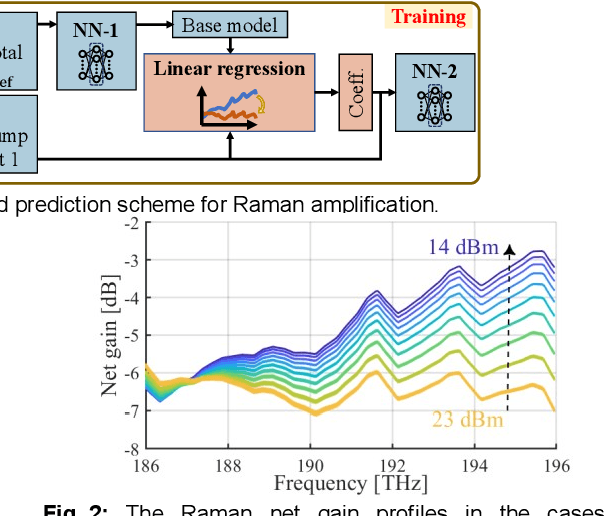
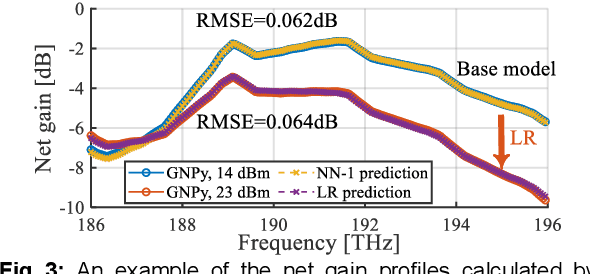
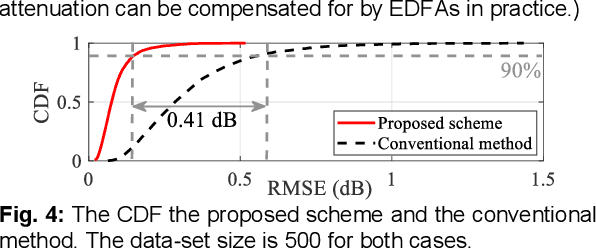
Abstract:Based on the physical features of Raman amplification, we propose a three-step modelling scheme based on neural networks (NN) and linear regression. Higher accuracy, less data requirements and lower computational complexity are demonstrated through simulations compared with the pure NN-based method.
Physics-informed EDFA Gain Model Based on Active Learning
Jun 13, 2022
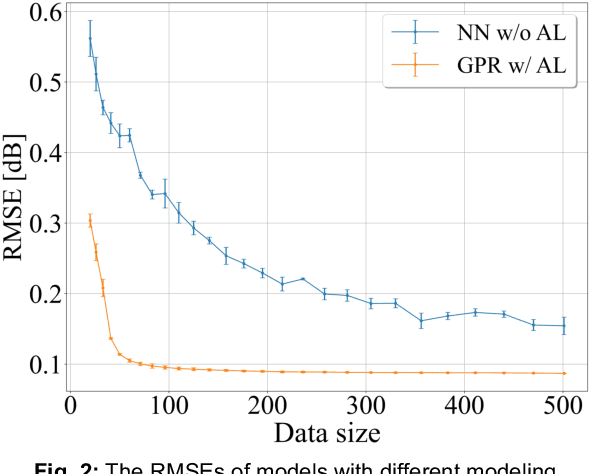
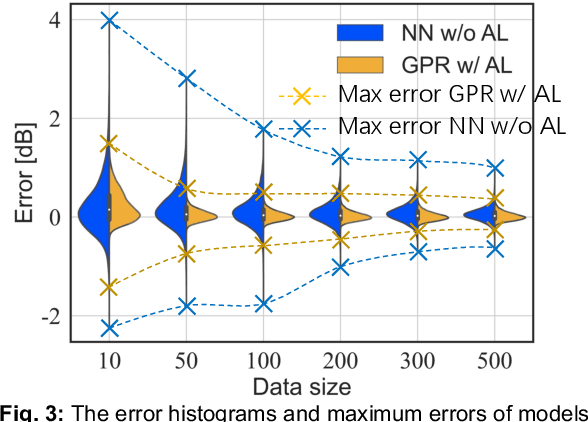
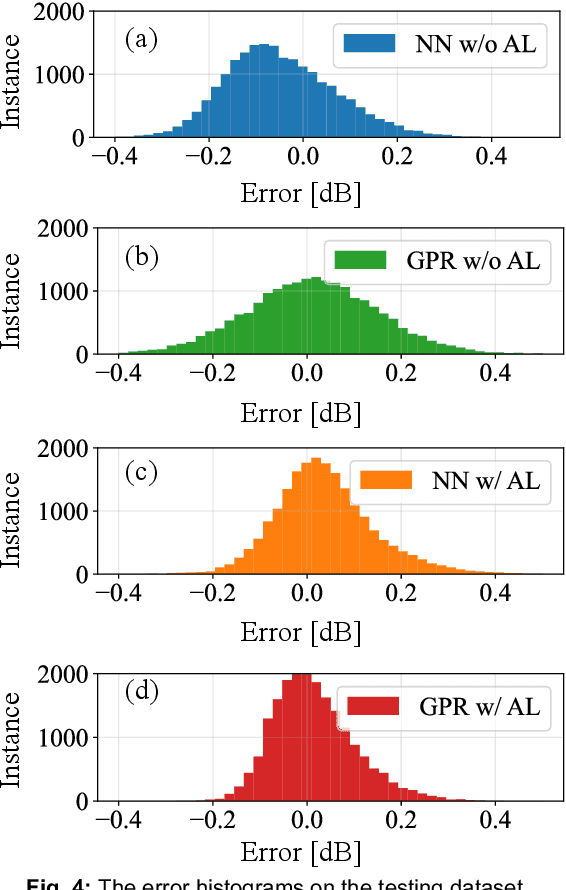
Abstract:We propose a physics-informed EDFA gain model based on the active learning method. Experimental results show that the proposed modelling method can reach a higher optimal accuracy and reduce ~90% training data to achieve the same performance compared with the conventional method.
Fast and accurate waveform modeling of long-haul multi-channel optical fiber transmission using a hybrid model-data driven scheme
Jan 18, 2022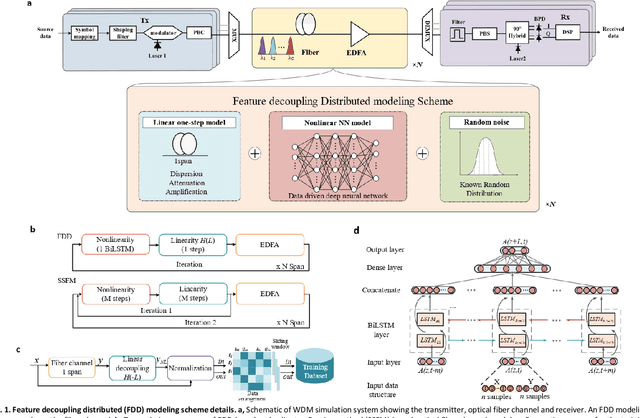

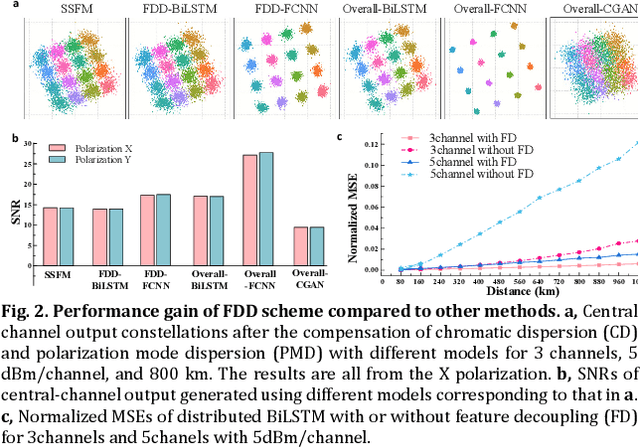
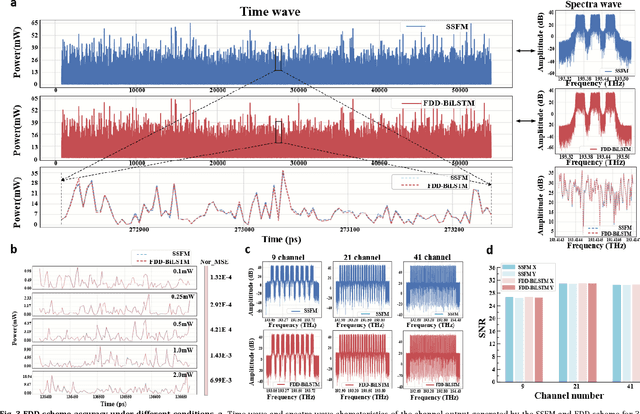
Abstract:The modeling of optical wave propagation in optical fiber is a task of fast and accurate solving the nonlinear Schr\"odinger equation (NLSE), and can enable the optical system design, digital signal processing verification and fast waveform calculation. Traditional waveform modeling of full-time and full-frequency information is the split-step Fourier method (SSFM), which has long been regarded as challenging in long-haul wavelength division multiplexing (WDM) optical fiber communication systems because it is extremely time-consuming. Here we propose a linear-nonlinear feature decoupling distributed (FDD) waveform modeling scheme to model long-haul WDM fiber channel, where the channel linear effects are modelled by the NLSE-derived model-driven methods and the nonlinear effects are modelled by the data-driven deep learning methods. Meanwhile, the proposed scheme only focuses on one-span fiber distance fitting, and then recursively transmits the model to achieve the required transmission distance. The proposed modeling scheme is demonstrated to have high accuracy, high computing speeds, and robust generalization abilities for different optical launch powers, modulation formats, channel numbers and transmission distances. The total running time of FDD waveform modeling scheme for 41-channel 1040-km fiber transmission is only 3 minutes versus more than 2 hours using SSFM for each input condition, which achieves a 98% reduction in computing time. Considering the multi-round optimization by adjusting system parameters, the complexity reduction is significant. The results represent a remarkable improvement in nonlinear fiber modeling and open up novel perspectives for solution of NLSE-like partial differential equations and optical fiber physics problems.
An Interpretable Mapping from a Communication System to a Neural Network for Optimal Transceiver-Joint Equalization
Mar 23, 2021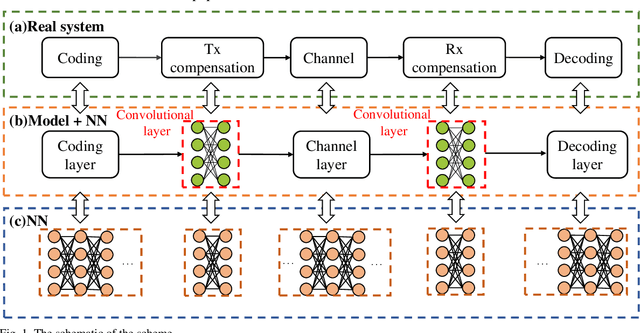
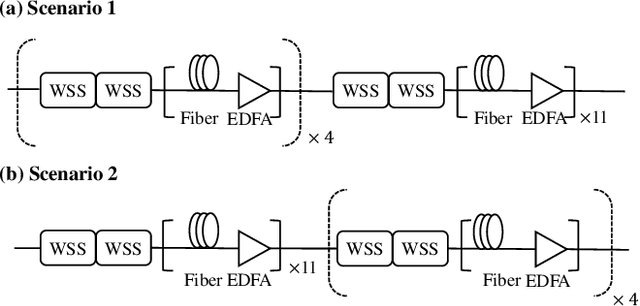
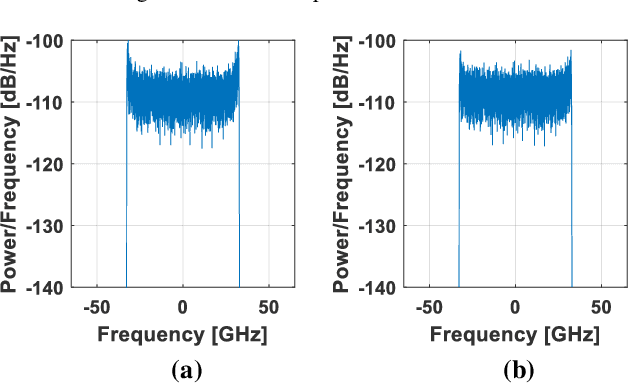
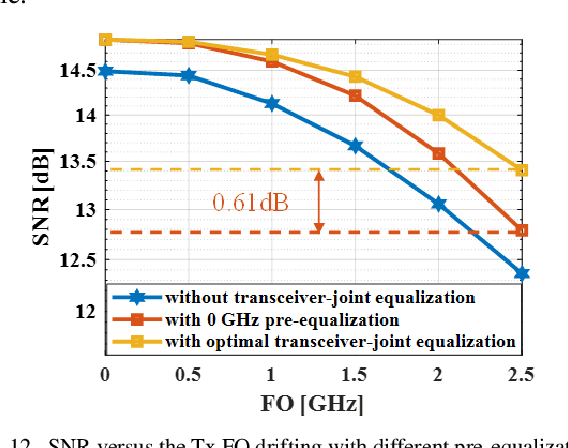
Abstract:In this paper, we propose a scheme that utilizes the optimization ability of artificial intelligence (AI) for optimal transceiver-joint equalization in compensating for the optical filtering impairments caused by wavelength selective switches (WSS). In contrast to adding or replacing a certain module of existing digital signal processing (DSP), we exploit the similarity between a communication system and a neural network (NN). By mapping a communication system to an NN, in which the equalization modules correspond to the convolutional layers and other modules can been regarded as static layers, the optimal transceiver-joint equalization coefficients can be obtained. In particular, the DSP structure of the communication system is not changed. Extensive numerical simulations are performed to validate the performance of the proposed method. For a 65 GBaud 16QAM signal, it can achieve a 0.76 dB gain when the number of WSSs is 16 with a -6 dB bandwidth of 73 GHz.
 Add to Chrome
Add to Chrome Add to Firefox
Add to Firefox Add to Edge
Add to Edge